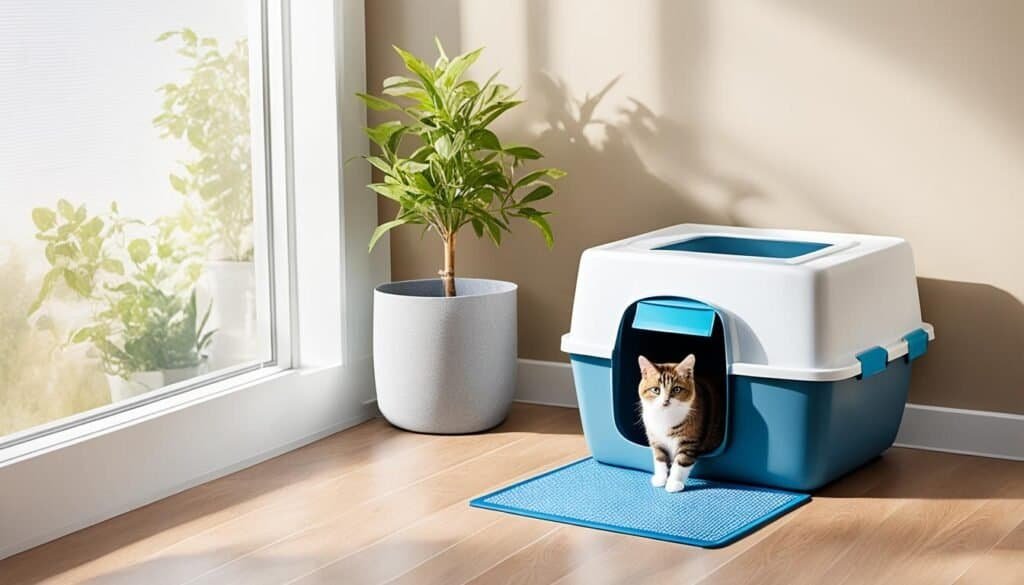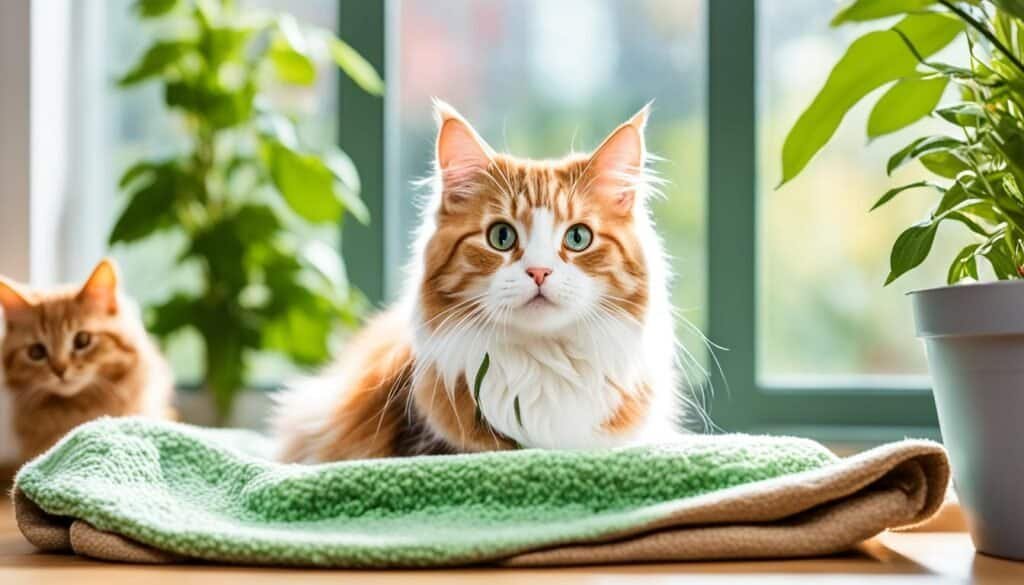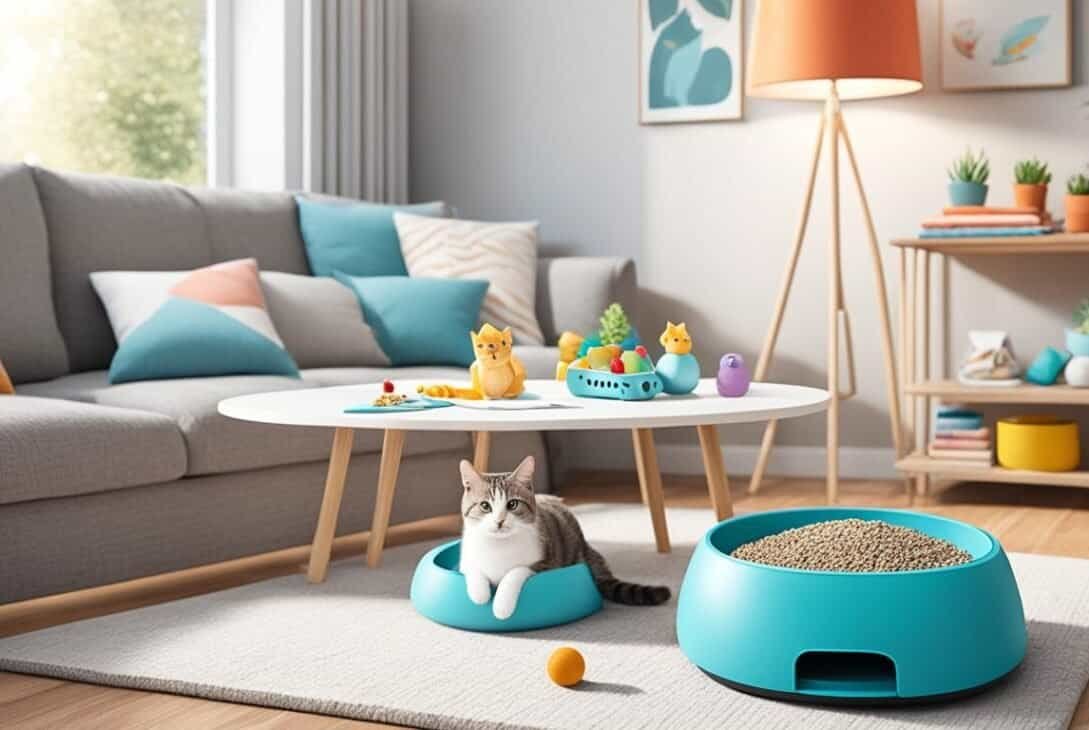Are you excited about bringing a new furry friend into your home? Preparing your home for cat is essential to create a safe and comfortable environment for them. From setting up a designated space to cat-proofing your home, there are some key steps you can take to ensure a smooth transition for your new feline companion.
Key Takeaways:
- Create a quiet and comfortable space for your cat, such as a spare bedroom or a cozy corner in your living room.
- Provide essential supplies like food and water bowls, a bed, a litter tray, a scratching post, toys, and a cat carrier.
- Cat-proof your home by removing potential hazards like loose threads on carpets and toxic plants.
- Consider providing vertical spaces and window perches for your cat to climb and observe their surroundings.
- Secure your furniture by using deterrents and providing alternative scratching surfaces.
- Set up a litter box in a quiet and easily accessible location.
- Introduce a new cat to your home gradually, using scent swapping and supervised interactions.
- Take care of your indoor cat’s mental and physical well-being through interactive toys, regular grooming, and veterinary care.
Creating a Cat-Friendly Environment
When preparing your home for a new cat, it’s important to create an environment that is not only safe but also cat-friendly. By providing the right features and amenities, you can ensure that your cat feels comfortable, stimulated, and happy in their new surroundings.
Vertical Spaces
Cats love to climb and explore, so it’s essential to provide them with vertical spaces in your home. Consider investing in cat trees or shelving units that allow your cat to climb, perch, and observe their surroundings. These dedicated vertical spaces will satisfy their natural instinct to climb while giving them a designated area of their own.
Window Perches
Installing window perches or shelves near windows is a great way to create a safe and comfortable spot for your cat to observe the outside world. Cats love watching birds, squirrels, and other outdoor activities, and a window perch provides them with a perfect vantage point. Make sure these perches are sturdy and secure to prevent any accidents.
Cat-Proofing Tips
When creating a cat-friendly environment, it’s important to remove or secure any potential hazards. Keep small objects, cords, and toxic plants out of reach to prevent accidents and injuries. Cats are curious creatures, and it’s essential to ensure their safety by minimizing any risks in your home.
Interactive Toys and Puzzle Feeders
Cats need mental stimulation and exercise to keep them happy and healthy. Providing them with interactive toys and puzzle feeders can fulfill their natural hunting instincts and keep them entertained. These toys challenge their minds and provide an opportunity for physical activity, preventing boredom and behavior problems.
Creating a cat-friendly environment is crucial when welcoming a new feline companion into your home. By considering vertical spaces, window perches, cat-proofing tips, and providing interactive toys, you can ensure that your cat has a stimulating and comfortable living space that meets their needs.
Securing Furniture for Cats
Cats love to scratch, and providing them with appropriate outlets for this behavior is essential for keeping your furniture safe. Here are some cat-proofing tips to secure your furniture and redirect your cat’s scratching instincts:
- Invest in sturdy scratching posts or boards and place them strategically in areas where your cat spends the most time. This will give them an alternative surface to scratch and satisfy their natural instincts.
- Use deterrents like double-sided tape or aluminum foil on furniture to discourage your cat from scratching. Cats dislike the sticky texture or sound these materials create.
- Provide alternative surfaces, such as cardboard scratchers, to redirect your cat’s scratching behavior. These scratchers can be placed next to or near the furniture your cat tends to target.
- If your cat has a tendency to jump on counters or furniture, consider using deterrents like sticky pads or motion-activated deterrents. These tools can help train your cat to stay off these surfaces.
Remember, it’s important to be patient and consistent when redirecting your cat’s behavior. Provide positive reinforcement when they use the appropriate scratching posts or surfaces, and avoid punishing them for scratching furniture. With time and proper redirection, you can help your cat develop healthy scratching habits and protect your furniture.
Setting Up a Litter Box
When preparing your home for a cat, one of the essential tasks is setting up a litter box. The litter box provides a designated area for your cat to relieve themselves, ensuring a clean and hygienic environment.
To set up a litter box, consider the following:
- Choose the right location: Select a quiet and easily accessible spot for the litter box. Cats prefer privacy when using the litter box, so avoid placing it in high-traffic areas or near their food and water bowls.
- Size matters: Opt for a litter box that is large enough for your cat to comfortably move around in. Cats appreciate having ample space to dig and cover their waste.
- Choose the right litter: Some cats are sensitive to strong smells, so it’s best to use unscented litter. Experiment with different types of litter to find the one that your cat prefers.
- Keep it clean: Scoop the litter box daily to remove waste and clumps. Regular cleaning helps maintain hygiene and prevents odors. Additionally, replace all the litter and clean the box thoroughly at least once a week to promote a fresh environment.
- Multiple cats, multiple boxes: If you have multiple cats, it’s recommended to provide one litter box per cat, plus one extra. This ensures that each cat has their own designated space and helps prevent conflicts.

By following these tips, you can create a comfortable and inviting space for your cat to use the litter box. Remember, maintaining cleanliness and providing multiple options is key to ensuring your cat’s litter box experience is stress-free.
Introducing a New Cat to Your Home
When it comes to introducing a new cat to your home, it’s crucial to proceed with caution and prioritize a stress-free transition. Follow these steps to ensure a smooth integration:
- Start by confining the new cat to a separate room equipped with all their essential items, including food, water, a litter box, and a cozy bed. This allows them to become familiar with their surroundings and establish a sense of security.
- Allow the resident cats to sniff and get accustomed to the new cat’s scent by swapping bedding or gently rubbing a cloth on each of them. This process helps them recognize and accept the presence of the new feline.
- Gradually introduce the cats to each other by using a cracked door or a baby gate. This physical barrier allows them to see and sniff each other while preventing any potential aggressive encounters.
- Observe their behavior closely during these initial interactions. Look for signs of aggression or anxiety, such as hissing, growling, or excessive stress. If any negative behavior occurs, separate the cats and slow down the introduction process.
- As the cats become more comfortable with each other, gradually increase their time together under supervision. Provide positive reinforcement such as treats and praise for calm and friendly interactions.

Remember, patience is key when introducing a new cat to your home. Each cat is unique, and the integration process may vary in duration. By following these steps, you can help foster a harmonious environment where your feline companions can coexist peacefully.
Indoor Cat Care Tips
Indoor cats require specific care to ensure they stay happy and healthy. Here are some important tips to keep in mind:
- Provide Mental and Physical Stimulation: Indoor cats need regular mental and physical exercise to prevent boredom and promote overall well-being. Use interactive toys, such as puzzle feeders or treat-dispensing toys, to keep them mentally engaged. Regular play sessions with interactive toys or a laser pointer can provide physical stimulation and help them stay active.
- Groom Regularly: Regular grooming is important for indoor cats to keep their coat clean and healthy. Brushing them helps remove loose hair and prevents mats. Additionally, it allows you to check for any signs of skin issues or parasites. Consider using cat-friendly grooming tools and establish a grooming routine that your cat is comfortable with.
- Maintain a Balanced Diet: It’s essential to monitor your indoor cat’s weight and provide them with a balanced diet to prevent obesity. Consult with your veterinarian to determine the appropriate portion sizes and feeding schedule for your cat’s age, breed, and activity level. Avoid overfeeding and opt for high-quality cat food that meets their nutritional needs.
- Regular Veterinary Check-ups: Regular visits to the veterinarian are crucial for maintaining your indoor cat’s health. Schedule routine check-ups to monitor their overall well-being, address any potential health concerns, and receive necessary vaccinations. Your veterinarian can provide guidance on preventive treatments for fleas and worms, keeping your cat protected.
- Create a Safe and Comfortable Environment: Indoor cats rely on their environment for mental stimulation and comfort. Ensure your home has plenty of hiding spots, such as cozy cat beds, enclosed cat trees, or cardboard boxes. Vertical spaces, like cat shelves or perches, allow them to explore their surroundings and find a space to relax. Create a cat-friendly environment by investing in scratchers and providing designated areas for scratching to protect your furniture.
Following these indoor cat care tips will help ensure that your feline companion leads a happy and healthy life within the comfort of your home.
Conclusion
Preparing your home for a cat is an essential step in ensuring their safety and happiness. By following these tips, you can create a welcoming environment that your new feline friend will love.
Start by cat-proofing your home. Remove potential hazards and provide essential supplies like food and water bowls, a comfortable bed, a litter tray, and a scratching post. These items will help your cat feel secure and meet their basic needs.
Introduce your new cat to their surroundings gradually, especially if you have existing pets. This will allow them to adjust at their own pace and reduce stress for everyone involved. Patience is key during this process.
Lastly, create a cat-friendly environment with vertical spaces, such as cat trees or shelves, interactive toys, and regular grooming and veterinary care. These elements will keep your cat mentally and physically stimulated, contributing to their overall well-being.
Enjoy the rewards of having a cat in your home. Their companionship and love can bring immense joy to your life, and with proper preparation, you’ll be ready to welcome them with open arms.
FAQ
How can I prepare my home for cat?
How can I create a cat-friendly environment in my home?
How can I secure my furniture for cats?
What should I consider when setting up a litter box?
How should I introduce a new cat to my home?
What are some indoor cat care tips?
Last modified: March 4, 2024













